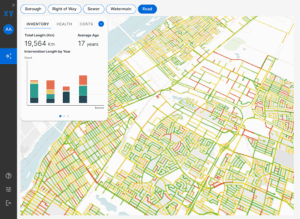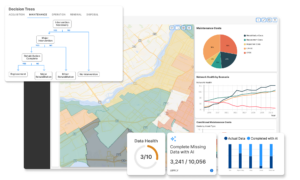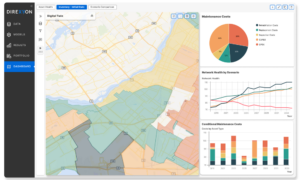Overcoming the challenges of traditional asset management
Modern business has reached an inflection point where the complexity of our asset management and capital planning has outstripped the capabilities of the available tools.
Building manual projections using spreadsheets and traditional asset investment planning (AIP) software doesn’t cut it when you have portfolios of millions of assets in complex, dynamic models. Environmental, social, and economic uncertainty doesn’t make long-term forecasting any easier, either. Instead, you need to take a proactive approach to planning.
This article unpacks the three primary challenges asset managers in the energy sector face in sticking with traditional asset management tools. We then explore how optimized capital planning software can help them overcome those challenges.
Traditional asset management challenges
Traditional asset management tools struggle with managing timeframes, complex asset lifespans, and adverse events.
Timeframes
Human beings tend to underestimate the number of variables and decision points that creep into projects with long timeframes. Costs and options are spread over many years, and different options must be considered on different time scales. As a result, generating meaningful insights that can inform short-term decision-making from within those long-term models can be difficult.
Complex lifespans
Deterministic models look for an average, most likely outcome. That has value, but that specific outcome is unlikely to occur. Organizations with expensive assets—like power grids or highway networks—need specifics to consider.
Using deterministic projections also makes end-of-life decision-making exceedingly difficult when you’re considering large asset sets. For example, say you’re responsible for managing solar farms. Your manufacturer says your solar panels have a projected lifespan of 15 years. So, a traditional, deterministic model will assume your panels will all reach the end of life on the exact same day, 15 years from now.
Unfortunately, real life doesn’t work that way. Your panels will reach the end of life at quite different rates depending on their local environment and usage patterns.
Adverse events
In real life, planning for the unexpected is crucial. Unfortunately, traditional modeling that shows average outcomes doesn’t help much when facing catastrophic adverse events. Assets fail in a catastrophe, or they don’t. There isn’t a middle ground.
If a major storm affects 20% of your power lines, that will have major real-life consequences for both your short-term and long-term CapEx and OpEx spending. And power is down for millions of people.
Trucks need to get on the road and know where to go. Your executives will want new budgets and projections on their desks in the morning. So, you must recalibrate all the time.
Overcoming these asset management challenges with capital planning solutions
Balancing short-term and long-term decision-making is challenging. This is because so many factors influence each timescale, and they also influence each other. Thanks to its advanced suite of stochastic modeling and other tools, capital planning software helps you determine whether you’re underinvested or overinvested for different assets on a wide range of time scales.
Direxyon’s solution helps you make informed long-term and short-term optimization choices. You want to do both, but it is important to strike a balance. To help you do that, Direxyon offers a few key capabilities that set it apart, including:
- Business-focused digital twin modeling
- Decision trees
- Real option valuation
- Stochastic integrated modelling and Monte Carlo simulation
- Calculating real risk and risk tolerance
- Advanced projectization and optimization tools
Business-focused digital twin modeling
Digital twin modeling is a vital tool in the kit of modern asset managers. But existing digital twin technology tends to focus on the small-scale minute-to-minute and second-to-second operational data streams from IoT sensors and technicians on the ground. While it’s important data, it isn’t necessarily what capital planners need to know.
That is why Direxyon decision analytics software focuses on building business-focused digital twins of your assets that capture relevant data from weekly, monthly, or quarterly data streams that matter for your specific asset types.
Consider an electric utility pole. Not much happens to individual poles minute-to-minute that an asset manager cares about. But let’s say your engineers perform a vegetation survey on that pole once a year. That’s the data you want for next-generation capital planning for your budgeting and forecasting.
By building a business digital twin, you’re looking to consolidate data from those various important sources so you can answer questions like:
“When do I touch that asset?”, “How do I optimize maintenance intervals?” and “When am I going to have to replace it?”
Implementing business digital twins isn’t a complex data gathering or endless integration project either. You can seemlessly integrate your organizational expertise and different data sources into one platform in its native form without having to change it, stage it or put in into a custom repository, enabling you to keep costs down and to create real value from your data.
Decision trees
Asset management requires solid math, and Direxyon provides that in its business digital twin system, stochastic modeling, and real risk calculations. But that is all still just data. Asset managers still need to make decisions.
The way that we display decisions graphically is in a decision tree. You visualize your millions of assets. For example, you might have millions of poles, transformers, and thousands of substations.
What trade-offs do you need to make? When should you choose this way or that? If you suffer a catastrophic event, you want to adjust the underlying logic of your decisions. That is what a decision tree does for you. It is a set of logic that allows for rapid adjustments in decision modeling.
So if you need to recalculate after an adverse event and your C-suite wants to know what unexpected inflation might do to your projections, instead of convening a series of meetings and working for months, you just drag and drop a few variables. Several hours later, you have a whole modeled decision tree that would have taken months before.
Real option valuation
This is another way Direxyon helps you model real-world choices and consequences and find value. For example, real option valuation (ROV) helps you take complex forecasts and identify the opportunity cost of continuing with a given project on a certain track or shifting to take a different action.
Stochastic modeling and Monte Carlo simulation
No matter what you’re managing, a power grid, transit system, or municipal pipe network, your systems are complex. You can’t deal solely with averages and generalities. You need nuanced, specific scenarios. Stochastic modeling helps you understand realistic asset behavior, not just ideal projections.
For example, an electrical transformer next to a hospital has more value than a transformer next to your house. If your house goes out for a few hours, it is inconvenient. But if a hospital goes out for a few hours, you must repair it before its generator runs down.
That’s a real-world human concern. Stochastic modeling in Direxyon takes those factors into account.
Many existing asset management solutions include Monte Carlo simulation capabilities. But they are especially powerful when combined with stochastic modeling capabilities, like in Direxyon. As a result, you can easily model viable projections for decades in the future.
Calculating real risk & risk tolerance
Direxyon helps you perform risk calculations based on the aggregation of all possible outcomes of each probable future paired with confidence intervals. It includes rigorous tools for risk identification, risk analysis, and risk mitigation. The focus is, again, on real-world outcomes.
Projectization & optimization
These capabilities give you a clear picture of your choices over the long term and how they’ll help you meet your strategic goals. But in the here and now, your organization must make choices to keep the lights on—often literally. You might have a hundred projects going during any given month. You need to keep them structured and optimized in the right order with the right resources in the right location and time.



